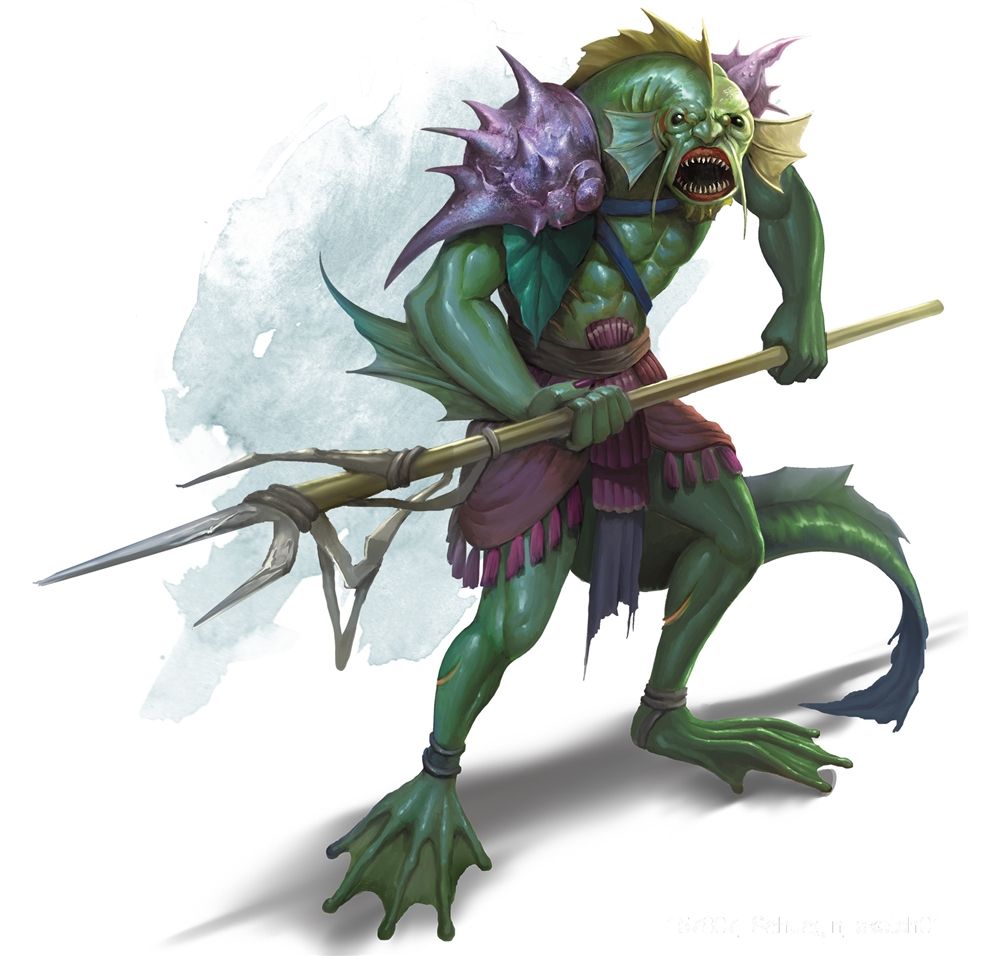Koalinth
| Species | humanoid (goblinish) |
| No. Appearing | 3–30 |
| Behaviour | clan |
| Range | intertidal |
| Size | 6 ft. 6 in. tall |
| Weight | 240 lbs. |
| Intelligence | 10 |
| Armour Class | 4 |
| Hit Dice | 1+1 |
| Action Points | 5 |
| Max. Stride | 5 |
| THAC0 | 20 |
| Hp/Die | d8 |
| Attack Forms | claw or weapon |
| Damage | 1–8 or by weapon type |
| Special Attacks | infravision, surprise on a 1–3 |
Koalinths are distantly related to hobgoblins, though their origin on the earth is uncertain, as there is no record of their emergence through the Kodar Gate with their terrestrial kin. They are tall, muscular humanoids, possessing lean but powerful builds suited to aquatic life. Their skin tends toward dark green or olive tones, often mottled for camouflage, and their facial features are sharp and angular, with eyes adapted to dim underwater light. Their hands are broad and thick, fully webbed, yet capable of gripping weapons with precision, making them competent fighters in both submerged and shallow water engagements.
Contents
Koalinth feet are broad and shaped into flexible triangular pads, allowing them limited land movement—sufficient for travel across beaches or wet shorelines for several hundred feet, but unsuited to extended terrestrial activity. As such, they do not raid inland and rarely leave the coastal or littoral zones. Their gill slits are set into tough muscle nodes beneath the neck, each roughly eight inches across, which visibly pulse as they breathe. Though undeniably intelligent and organised, koalinths have no known homeland or fixed domain. They dwell in scattered tribal groups, often in submerged ruins or sea caves, and are encountered only rarely, usually near remote or uncharted coastal waters.
History
During the classical period, koalinths were known to inhabit the shallow sealands of the eastern Mediterranean, where they established a reputation as elusive but formidable maritime fighters. Historical records indicate that Alcibiades employed koalinth mercenaries during the later years of the Peloponnesian War, using their talents to harass enemy shipping and strike coastal targets with impunity. The Romans, too, engaged them in naval operations, notably paying koalinth forces to sabotage Achaean trade routes in the 3rd century BCE.
However, their relations with surface powers grew increasingly hostile. Hundreds of koalinths were massacred in Crete during the Social War of 219 BCE, and further violent purges occurred under the Seleucan emperors Demetrius I in 160 BCE and Alexander Balas in 150 BCE. By the time of the Roman consolidation of the Mediterranean, koalinths had retreated into deeper waters and greater secrecy, vanishing from common record. During the Dark Ages, sightings became so rare that many considered them the stuff of sailors’ legends.
Among scholars, however, it is generally accepted that isolated populations of koalinths persist in the offshore waters around the Ionia, the Dodecanese and the Crete. Another possible aggregation is thought to exist between the island of Malta and the Sicilian mainland. These suppositions are drawn primarily from the infrequent recovery of koalinth corpses that wash ashore in these regions, often bearing signs of injury or illness. Direct encounters are vanishingly rare, and koalinths themselves remain hostile toward all forms of intrusion. Expeditions dispatched to investigate underwater structures or unusual activity in the aforementioned waters have frequently disappeared without trace. As a result, the current extent, structure, and population of koalinth society remain unknown.
Behaviour
Partial evidence from classical sources suggests that koalinths traditionally co-exist in polyamorous clan-based units, in which males typically outnumber females by a ratio of two to one. These clans appear to be structured around tightly knit kinship bonds and shared responsibilities in both hunting and defence. Koalinths are born in pairs, in the same manner as hobgoblins, and while they reach physical maturity for combat after approximately three years, it is customary that they are not permitted to take part in raids or open warfare until they have reached at least eight or nine years of age. During these formative years, they are expected to observe, train and support more experienced warriors.
Each clan is led by two sub-chiefs, likely to represent a form of balanced leadership or shared authority. These sub-chiefs are supported by a cadre of four to six leaders, each responsible for different facets of clan life, including tactics, resource management and external scouting. In antiquity, multiple clans would unite under a single tribe, directed by a warchief—a figure of extraordinary martial experience and leadership, often of at least 10th level, known for command over significant puissance. These warchiefs were renowned for their strategic acumen and magical resilience, commanding both fear and respect from their enemies and allies alike.
It remains uncertain whether the present-day koalinth population is sufficiently numerous to sustain this former tribal structure. With sightings sparse and no verified reports of organised tribal activity in centuries, scholars question whether any surviving warchiefs remain. The last known warchief, Sekgatalatch, perished during the massacre on Crete in the Social War of 219 BCE. Since that time, the koalinth presence has been fragmented and largely invisible, giving rise to speculation that only clan-sized groups continue to persist in isolated pockets along the seafloor.
Fighting
Little is known about this. Historically, koalinths fought with a four-barbed trident known as a metch, a weapon designed for use with both hands. The metch inflicted 1–10 damage and featured a specialised hook used to drag stunned opponents off their feet when a sufficiently forceful hit was delivered. Measuring nearly 8 feet in length and weighing 14 lbs., the metch was both a piercing and control weapon, effective in underwater combat where mobility and leverage could determine the outcome of a fight. Koalinths did not wear armour, relying instead on their speed, environment, and coordination to overwhelm targets.
See Bestiary
